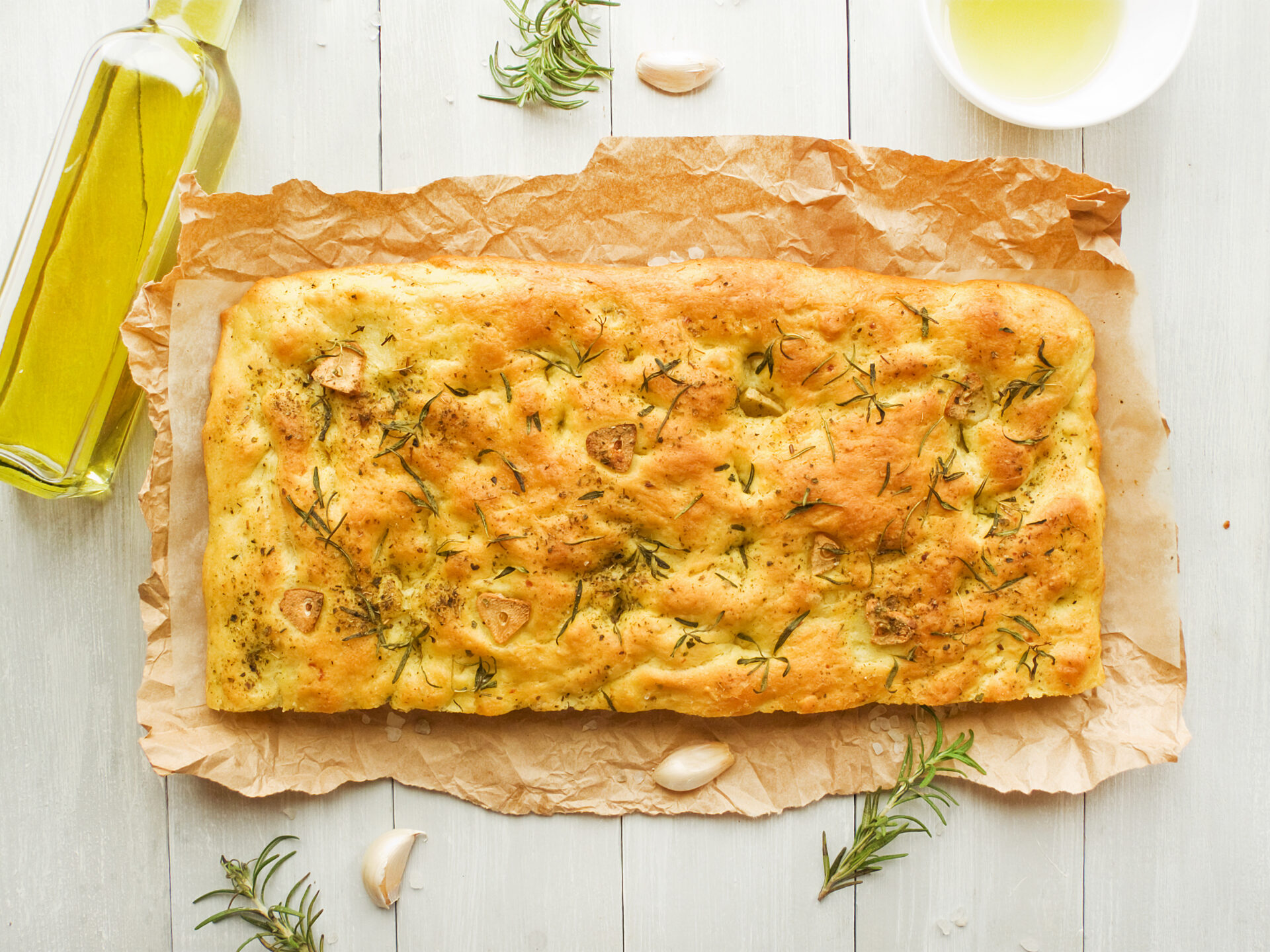
Today we’re going dive deeper into the world of one of Italy’s most beloved bread creations: focaccia. If you’ve ever marveled at its golden crust, inhaled its fragrant aroma, or delighted in its pillowy texture, you know what we’re talking about. Maybe you’ve assumed it’s an amazing treat but nothing you could possibly make at home… but think again! We’re going to show you just how easy it is to make focaccia at home and what you can do with your delicious creation.
In the beginning…
Focaccia’s roots trace back to the sun-drenched hills of Liguria, Italy, where bakers have been perfecting the art of bread-making for centuries. At its core, focaccia is a simple bread, made from just a handful of humble ingredients: flour, water, yeast, salt, and olive oil. But it’s the technique that transforms these basic elements into something truly extraordinary.
The process begins by mixing the flour, water, yeast, and salt to form a soft, elastic dough. This dough is then left to rest and rise, allowing the yeast to work its magic and create those delightful air pockets that give focaccia its signature texture.
But here’s where the magic really happens: the dimples. Traditionally, focaccia is pressed and stretched onto a baking sheet, then generously drizzled with olive oil and sprinkled with coarse salt. And here’s the fun part: using your fingers, you gently press down into the dough, creating those iconic dimples that are not only visually appealing but also serve a practical purpose.
You see, those dimples aren’t just for show. They actually help create pockets of air in the dough, which expand during baking, giving focaccia its light and airy texture. Plus, they provide little reservoirs for that golden olive oil to pool in, infusing the bread with flavor and moisture as it bakes.
Once the dough is dimpled to perfection, it’s left to rise again, allowing it to puff up and double in size. Then, it’s off to the oven, where it bakes until golden brown and irresistibly fragrant.
Focaccia is different from regular bread because of the hard crust on both sides of the bread along with its “flat” appearance. While focaccia is thick and fluffy, it is often referred to as Italian Flatbread because it doesn’t have the same rise as other breads such as sandwich bread we’re used to.
DIY
Now, let’s talk about making focaccia at home. While it may seem daunting at first, we promise you, it’s easier than you think. Here are a few tips and tricks to ensure your homemade focaccia turns out perfect every time:
- Quality Ingredients: Start with good-quality flour, preferably bread flour or all-purpose flour. Use extra virgin olive oil for that authentic flavor. This is going to make it taste much better.
- Don’t Rush the Rise: Let the dough rise slowly in a warm place. This allows the flavors to develop and gives the bread its signature airy texture.
- Get Creative with Toppings: While traditional focaccia is delicious on its own, feel free to get creative with toppings. Try cherry tomatoes, olives, caramelized onions, or even slices of potato for a unique twist.
- Don’t Skimp on the Olive Oil: Focaccia is meant to be rich and indulgent, so don’t be afraid to be generous with the olive oil. It adds flavor and helps create that crispy crust.
- Experiment with Flavors: Sample different herbs and seasonings. From garlic and parmesan to chili flakes and sea salt, the possibilities are endless.
We have the perfect recipe to get started with our Roasted Tomato and Basil Focaccia.
Focaccia: What is it good for?
Now that you’re feeling a little more confident to try your hand at focaccia, what are you supposed to use it for? Sure, it tastes great but what else do we do with it?
Thankfully, focaccia is incredibly versatile and can be used in a variety of ways. Here are a few ideas to get you started:
- Focaccia Detroit Style Pizza: Simply press the dough into a well-oiled pan (trust us, use olive oil for this), add your cheese first (Detroit style, after all), sauce, and toppings of choice, and bake until golden and bubbly.
- Focaccia Bruschetta: Toast slices of focaccia until golden, then top them with diced tomatoes, fresh basil, garlic, and a drizzle of balsamic glaze for a tasty appetizer or snack.
- Focaccia Sandwiches: Slice your focaccia horizontally and fill it with your favorite sandwich fixings for a hearty lunch or dinner option. We have the perfect sandwich try it out right here.
- Focaccia Panini: Use sliced focaccia to make paninis by adding your choice of fillings like grilled vegetables, deli meats, and cheese, then pressing them in a panini press until golden and crispy.
- Focaccia Croutons: Cut leftover focaccia into bite-sized cubes, toss them with olive oil and your favorite seasonings, then bake until crispy. These make a delicious addition to salads or soups.
What other styles of breads, kitchen deep dives, or skills are your interested in learning about next? Help us answer your questions! Head over to our Facebook page and let us know what you’re wondering about! Maybe we’ll cover it next!
Don’t forget to sign up for our newsletter to be the first to hear about our new recipes, seasonings, and tips! There’s always something cooking here at The Real Kitchen!
